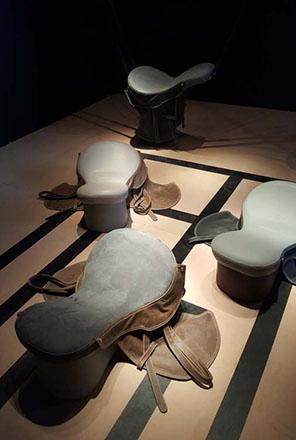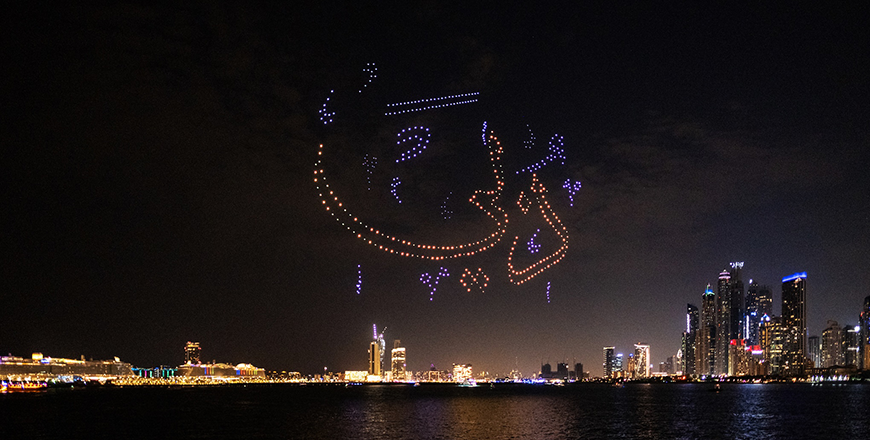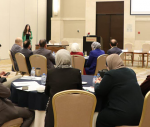You are here
Dubai Design Week reveals creativity
By Ica Wahbeh - Nov 01,2015 - Last updated at Nov 01,2015

Installations on display at the Dubai Design Week that closed on Saturday at the Dubai Design District (Photo by Ica Wahbeh)
DUBAI — The city where big spawns bigger, where to stay ahead, be relevant and competitive one has to permanently reinvent oneself has been doing just that, taking the Downtown Design, in its third edition, one step further by hosting the Dubai Design Week between October 26 and 31.
The event, held for the first time in the Dubai Design District, shortly called by acronym-loving organisers d3, brought together international and regional designers and buyers, and gave the public the opportunity to discover products of some of the world’s contemporary talent.
The just-inaugurated d3, two years ago on the drawing board and now a gleaming collection of buildings in the same attractive architectural style that, according to literature promoting it, “is not just a business district; it is an intelligently curated space designed for people and businesses operating in the fields of design, fashion, art and luxury”, wishes to be a place where designers cater to contemporary business needs, an inclusive space “for the entire creative community, from global brands to start-ups, from established names to new talent”.
What better place to start, then, than the design week, a massive happening that showcased design from the Middle East and beyond, and held talk programmes, workshops and panel discussions?
The design week also served as an introduction to the design scene in the UAE, offering insight to those interested in either the local or global design scene while addressing local concerns and issues of international impact, such as the human-centred design movement, the purpose and value of “design weeks” worldwide and the development of the design industry.
Established by Art Dubai Group in partnership with Dubai Design District, Dubai Design Week was also supported by Dubai Design and Fashion Council and Dubai Culture and Arts Authority. The intention was to place Dubai on the map as a design hub, “shining the international spotlight on the city and its exciting design talent”, according to organisers.
“In addition, in the spirit of collaboration and mirroring the city’s global outlook, the week also offers a platform for regional and international designers and brands... encompasses culture, education and entertainment, spanning multiple disciplines of design, from graphic and product design to architecture and industrial design.”
Over 120 designers from 35 countries took part in the design week, alongside “some of the world’s most influential industry figureheads, representatives from global academic institutions” and creative individuals from across the Middle East.
The aim: “To make a statement as bold and attention-grabbing as the spirit of the city itself, while encouraging the world to look beyond the expected and discover the balance of imagination and innovation that drives Dubai forward.”
There certainly was no shortage of imagination.
A tour of Abwab, a series of six pavilions built to showcase the work of designers, studios and curators from six different countries in the MENASA (Middle East North Africa and South Asia) region, was evidence of not only unbounded imagination, but also of activism, preoccupation with human condition and desire to maintain and recreate past values.
The Jordanian pavilion hosted the “Swing project”, an installation examining the “power of transformation through imagination”.
Appealing to the child in every human being, three architects, of which two are also visual artists, chose as subject the swing (murjeiha in Arabic), according to one of the artists, Dina Haddadin, “an intuitive game that has not need to explain”, that is interactive, lets the imagination free and defies gravity. Like in “empty canvas where you let your imagination free vs the heaviness of reality”, says Haddadin.
The seats, “representing the solid and grounded element with solid ideals and heritage from the Jordanian and Palestinian geology” are made of stone that bears the name of the cities and villages of their source: Ajloun, Karak, Halabat, Qabatia, Taffouh.
Swinging under milky fabric that represents “the more volatile and airy element that accompanies the dreaminess of imagination” and that contrasts with the heaviness
of the stone seat, the swings produce each a different sound, “like a symphony”, adding to the element of play and stimulating more senses.
Kuwait, Pakistan, Saudi Arabia, Tunisia and the United Arab Emirates were also present with interesting, thought-provoking installations that tackle, in the Saudi case, gender roles and the equestrian tradition through the use of saddles as seating pieces — creation of Aya Al Bitar — or, again appealing to the child in us, cleverly using the “Game of nine”, or “Mother of nine” (Um tse’), listed as one of the 10 most important games in history, played as far as 1400 BC, to emphasise texture, the Saudi culture and the
real interaction while playing, now replaced by “joysticks and no real grasp or bond with the objects used to play the game”.
“Brilliant Beirut”, curated and designed by Rana Salam, illustrates how the city, “with its melange of cultures, has produced world-
renowned designers and remains at the forefront of the design industry in the Arab world”.
The exhibition documents the development of design in the Lebanese capital over the past seven decades, since the country’s independence in 1943, pinpointing
key designers and monuments, and “great achievements that built the city’s reputation for its progressive design scene”, while shedding chronological light on the milestones of the city’s design history.
In the “Global grad show”, 10 universities present “the next generation of innovation”, featuring the work of 50 young international designers and teams, “each selected for their creative approach to problem solving and their potential to make a lasting improvement to human society across six themes: construction, home, health, memory, play and work”.
It was an impressive display of imagination and desire to make the planet a better place, which gives one hope for the future.
Placed in strategic locations throughout the city, 13 installations by local and international designers intended to challenge conventions or demonstrate a strong sense of belonging, exploring regional decorative traditions, technological possibility and human environment.
More than 100 events took place all over the city involving individual designers, studios, artists, architects, educational and cultural institutions, retail stores, iconic brands, trade professionals, authors and thinkers.
The Dubai Design Week was held under the patronage of Her Highness Sheikha Latifa Bint Mohammed Bin Rashid Al Maktoum, vice chairman of the Dubai Culture and Arts Authority.
Related Articles
AMMAN — Brightening the daily lives of locals while beautifying Amman’s facades was the purpose behind the creation of “Wajha”, an independe
AMMAN — This year, Dubai proudly celebrates the 30th anniversary of its iconic annual Dubai Shopping Festival (DSF) from December 6 2024 to&
Dubai and luxury are nearly synonymous. The city is home to the world’s tallest tower, massive man-made islands in the shape of palm trees and a fleet of police cars that includes a Ferrari, a Lamborghini and a $2.5 million Bugatti Veyron.


















